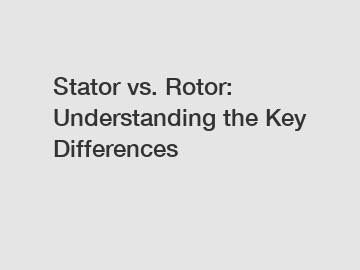Feb. 21, 2024
Hardware
CHME are exported all over the world and different industries with quality first. Our belief is to provide our customers with more and better high value-added products. Let's create a better future together.
When it comes to understanding the inner workings of an electric motor, two crucial components that play a vital role are the stator and rotor. These two components work in tandem to create the magnetic fields necessary for the motor to generate motion. In this blog post, we will delve into the key differences between the stator and rotor, shedding some light on their individual functions and importance in the overall operation of an electric motor.
Let's start with the stator. The stator is the stationary part of the motor that houses the coils of wire that generate a magnetic field when an electric current is passed through them. This magnetic field is pivotal in creating the rotating motion of the rotor. The stator is typically made up of laminated steel cores to reduce energy losses and increase efficiency. It is designed in a way that allows for the best possible interaction with the rotor to achieve optimal performance.

On the other hand, the rotor is the rotating part of the motor that is positioned within the stator. The rotor receives the magnetic field created by the stator, causing the rotor to rotate and produce mechanical energy. The rotor is typically made up of copper or aluminum bars that are connected by end rings to create a closed loop. The design and composition of the rotor are crucial in providing the necessary torque and speed required for the motor to function effectively.
One key difference between the stator and rotor lies in their respective functions. While the stator generates the magnetic field that drives the rotation of the rotor, the rotor is responsible for converting this magnetic energy into mechanical energy. The stator and rotor work together in a synchronized manner to ensure that the motor operates smoothly and efficiently.
Another key difference between the stator and rotor is their physical structure. The stator is stationary and is firmly fixed within the motor housing, while the rotor is free to rotate within the stator. This difference in mobility is essential in enabling the rotor to spin and generate the required mechanical energy for the motor to operate.
In terms of construction, the stator and rotor are both made up of different materials and components. The stator is typically made of laminated steel cores with coils of wire wound around them, whereas the rotor is made of conductive materials such as copper or aluminum bars. The difference in construction allows each component to perform its specific function within the motor effectively.
When it comes to maintenance and repair, both the stator and rotor play a crucial role. The stator requires regular inspection to ensure that the coils of wire are in good condition and that there are no signs of wear or damage. The rotor, on the other hand, may require occasional maintenance to ensure that the conductive materials are intact and that the end rings are properly connected.
Overall, the stator and rotor are two essential components of an electric motor that work together to generate motion and provide mechanical energy. Understanding the key differences between the stator and rotor is crucial in grasping the intricate workings of an electric motor and appreciating the role that each component plays in its overall operation.
In conclusion, the stator and rotor are integral components of an electric motor that work together to create motion and generate mechanical energy. The stator generates the magnetic field, while the rotor converts this energy into mechanical motion. Their distinct functions, physical structures, and materials make them essential parts of an electric motor that must work together harmoniously for optimal performance. Understanding the key differences between the stator and rotor is essential in gaining insight into the complexities of an electric motor's operation and the critical roles that these components play.
For more information, please visit our website.
If you want to learn more, please visit our website laminations stack welded components.
If you are interested in sending in a Guest Blogger Submission,welcome to write for us!
All Comments ( 0 )